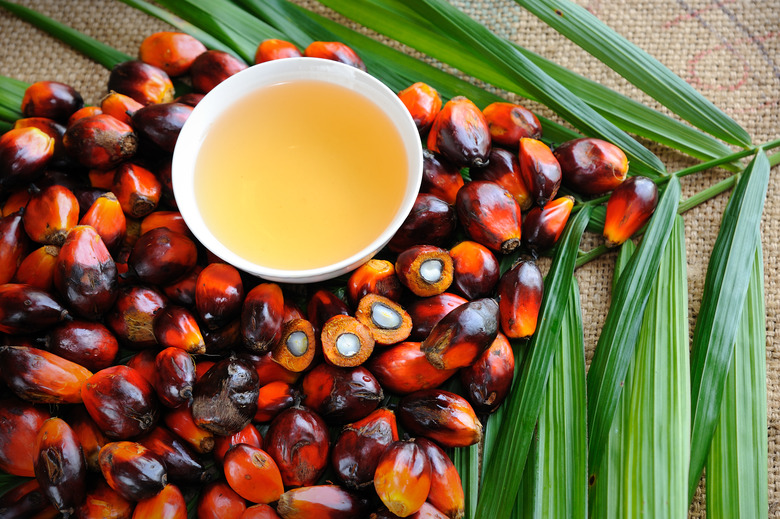The Oily Truth About Palm Oil
Among the most-consumed commodities on Earth, palm oil has quietly found its way into nearly half the products on grocery store shelves, from lipsticks to potato chips, and soaps to animal feed. And though it's helped developing countries make enormous economic advances, critics say palm oil comes at an intolerable cost.
Why Palm Oil?
Why Palm Oil?
Palm oil is derived from the fruit of the African oil palm, a crop that grows in humid tropics. A one-hectare plantation can produce as much as ten times more oil than that of other leading crops, making it the most efficient oilseed crop in the world.
In 2002, a National Academy of Sciences report unequivocally linked trans fatty acids to heart disease, opening the door for the oil palm industry to fill a void as consumers moved away from the partially hydrogenated oils used to enhance the flavor and shelf life of processed foods. In a short period, palm oil – the world's least expensive vegetable oil – quickly became the preferred cooking oil of millions across the globe. Since then, U.S. palm oil imports palm oil have risen approximately 485 percent, topping 1.27 million tons in 2016.
Today, 85 percent of palm oil is grown in Indonesia and Malaysia. For both countries, it's a highly profitable export crop. In 2014, Indonesia – the world's largest producer – exported 20 million of the 29.5 million tons it produced. Valued at US$21.6 billion, palm oil is the third-biggest contributor to the country's foreign exchange earnings, behind oil and natural gas. Malaysia is not far behind, with 2014-exports in excess of 17.3 million tons.
The Environmental Costs
The Environmental Costs
As demand for palm oil has surged, cultivation of the land used to produce it has increased globally. In major palm oil exporting countries, more than 270,000 hectares of species- and carbon-rich tropical forests were converted annually from 2000 to 2011, according to a study out of Duke University. And deforestation rates only continue to accelerate. Today, oil palm represents 5.5 percent of global cultivated land use.
Conservation biologists are deeply concerned by these trends. Malaysian and Indonesian rainforests are among the most biologically diverse places on Earth, and home to hundreds of mammal and bird species at risk of extinction, including Sumatran tigers, orangutans and helmeted hornbills.
The Indonesian Ministry of Forestry acknowledges that more than 1.17 million hectares of forest were cleared from 2003 to 2006. On the island of Sumatra, which has lost the most, more than 75 percent of the lowland forests birds are now globally threatened.
In a 2008-study published in Nature, Princeton-biologist David Wilcove found that conversion of Malaysia's primary and secondary forests to oil palm resulted in significant losses of biodiversity; in secondary forests, nearly three quarters of the bird and butterfly species disappeared.
Deadly Conflicts
Deadly Conflicts
Industry is quick to point out that many large plantations provide housing, medical care, education and other vital benefits to traditionally-poor workers and their families. But human-rights groups have concerns. In 2016. Amnesty International found subsidiaries and suppliers of Wilmar International, the world's biggest palm oil trader, used forced and child labor and exposed workers to toxic chemicals. Even-more troubling. opponents to palm oil – indigenous communities, farmers and activists – have been criminalized and even killed. In 2016, environmental activist Bill Kayong was shot and killed in Borneo. Kayong had been organizing a group of villagers in an effort to reclaim land the local government had transferred to the palm oil company, Tung Huat Niah Plantation. A director and major shareholder of the company was implicated, but fled prosecution.
A Sustainable Future for Oil Palm?
A Sustainable Future for Oil Palm?
Since 2004, the Roundtable on Sustainable Palm Oil (RSPO) has brought together a consortium of industry and non-governmental groups to improve the sustainability of palm oil production. But only a fraction of global palm-oil production is currently certified by the group.
Stuart Pimm, Doris Duke Professor of Conservation at Duke University and co-author of the study measuring palm-oil impacts on deforestation and biodiversity loss, has called sustainable palm oil an "oxymoron, if it clears tropical forest and drives species to extinction." In 2012, Pimm and nine other leading scientists sent a letter to the RSPO asking them to incorporate new standards to protect carbon-rich peatlands and biodiverse secondary forests. To date, the RSPO has not fully incorporated either in the minimum standards that every RSPO member must meet, leaving many NGOs to question if the program is "sustainable" in name only.
Cite This Article
MLA
Cozzens, Barbara. "The Oily Truth About Palm Oil" sciencing.com, https://www.sciencing.com/the-oily-truth-about-palm-oil-13400301/. 6 July 2017.
APA
Cozzens, Barbara. (2017, July 6). The Oily Truth About Palm Oil. sciencing.com. Retrieved from https://www.sciencing.com/the-oily-truth-about-palm-oil-13400301/
Chicago
Cozzens, Barbara. The Oily Truth About Palm Oil last modified March 24, 2022. https://www.sciencing.com/the-oily-truth-about-palm-oil-13400301/
